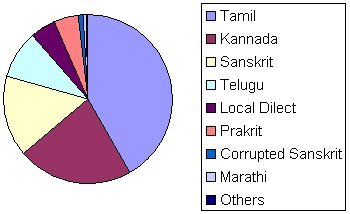Epigraphs and Copperplates Inscriptions form one of the sources for Indian history. Kings recorded their.. . https://en.m.wikipedia.org/wiki/Early_Indian_epigraphy
About 43000 inscriptions are found in Tamil Nadu. Apart from a wealth of information, what interested me most was the number of languages used in these records. Eight languages have been used! To my surprise Prakrit occupies the second place to Tamil.And Local language is also used. I am not sure what it is. Might be local dialect. Am providing image showing the percentage of languages used in these records.

Inscriptions.Languages used.
- Reign details
- Wars won,lost,
- Genealogy,
- Grants provided to the Temples,if any has been made or a temple built
- Or if a donation to a group of people are made
- Or donation by an individual to the temple or the Kings’ Coffers.
Information such as these are recorded in
- Temple walls.
- In Copperplates,which are left in the custody of some people or buried in a safe place.
- Written on Palm leaf 🍂.
Indian copper plate inscriptions are historical legal records engraved on copper plates in India.
Donative inscriptions engraved on copper plates, often joined together by a ring with the seal of the donor, was the legal document registering the act of endowment. It was probably necessary to produce them when required to prove ownership/ the claim to the rights. The retrievability of the copper plates was perhaps crucial in the newly settled lands. Detailed information on land tenures and taxation available from these copper plate grants….
Indian copper plate inscriptions (tamarashasana), usually record grants of land or lists of royal lineages carrying the royal seal, a profusion of which have been found in South India. Originally inscriptions were recorded on palm leaves, but when the records were legal documents such as title-deeds they were etched on a cave or temple wall, or more commonly, on copper plates which were then secreted in a safe place such as within the walls or foundation of a temple, or hidden in stone caches in fields. Plates could be used more than once, as when a canceled grant was over-struck with a new inscription. These records were probably in use from the first millennium.
Some of the oldest inscribed copper plates to be found in the Indian subcontinent date to the Mature Harappan era, consisting of up to 34 characters and thought to be used for copper plate printing…Indian Copperplates .
Epigraphy is the study of Inscriptions on Rocks, Pillars, Temple walls, Copper plates and other Writing-materials like Stones, Metals, Potteries, Woods, Palm leaves, Clothes, Conch shells, Mural paintings and Coins. It is one of the most fascinating and instructive studies. It deals with the art of writing, which distinguishes man from animals and provides us with an instrument for conservation and transmission of historical traditions from generation to generation. ….It has been estimated with a fair degree of accuracy that the inscriptions written in Tamil occupy the first position in volume, amounting nearly 20,000, followed by those in Kannada (10,600), Sanskrit (7,500) and Telugu (4,500). Inscriptions in Tamil language are noticed from the third century BCE onwards. (Source: Journal of the Epigraphical Society of India Volume 19 : 1993)….
A separate epigraphy wing was started during the year 1966. The primary function of this wing is to copy inscriptions on boulders, stone pillars, stones, temple walls and on copper plates. The inscriptions are deciphered,edited and published. So far, about 24,771 inscriptions are copied and their estampages (ink impression) are preserved in this wing. Some original copper plates and old palm leaf manuscripts are also under the custody of this department.
Department of Archaeology, Government of Tamil Nadu






Leave a comment